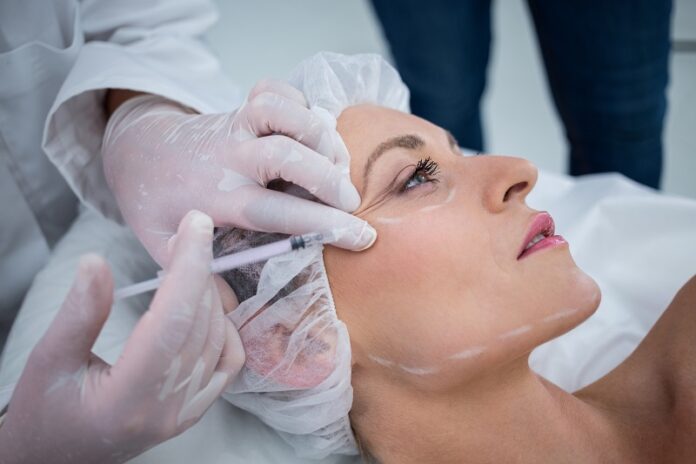Rhytidectomy, more commonly known as a facelift, is a cosmetic surgical procedure that aims to improve visible signs of aging in the face and neck. It involves the removal of excess skin, the tightening of underlying tissues, and the redraping of skin on the face and neck.
With advanced surgical techniques and technologies, rhytidectomy has become an increasingly popular way to achieve a more youthful appearance. However, there are many misconceptions and myths surrounding this procedure. It is important to separate facelift fact from fiction to make informed decisions.
This article will examine some of the most common rhytidectomy myths, provide evidence-based facts, and help readers understand the realities of a facelift. Expert opinions and insights will help debunk myths and set realistic expectations. The goal is to provide comprehensive information to make the truth about facelifts clear.
Common Myths About Rhytidectomy
There are many myths and misconceptions about rhytidectomy that lead to unrealistic expectations about the procedure. Here are 5 of the most common facelift myths:
1. Facelifts Provide a Tight, Artificial Look
A common myth is that facelifts pull the skin back tightly, leading to an unnatural, “windswept” appearance. In reality, an experienced, board-certified plastic surgeon will aim to achieve natural-looking results with minimal scarring. While some tightening is necessary, there should not be a major distortion of facial features.
2. Facelifts Only Address Loose Skin
While sagging skin is a common issue facelifts address, the procedure also tightens underlying muscle and tissue. An experienced surgeon will address multiple facial layers, not just the surface skin. This comprehensive approach leads to more complete rejuvenation.
3. Facelifts Are Only for the Elderly
Many people believe you need to be over 60 or 65 to get a facelift. However, patients in their 40s and 50s who are beginning to show signs of facial aging can benefit from a rhytidectomy. Determining candidacy depends on an individual’s unique needs and facial anatomy.
4. Any Plastic Surgeon Can Perform a Facelift
Facelifts require an intimate understanding of facial anatomy and advanced surgical techniques. Choosing a board-certified plastic surgeon with proven expertise in rhytidectomy is crucial for safe, optimal outcomes. Do not simply trust any provider claiming to perform facelifts.
5. Facelifts Require a Long, Arduous Recovery
Thanks to less invasive techniques, the recovery period for modern facelifts is much shorter. Swelling and bruising typically subside within 2 weeks. Most patients can return to non-strenuous work and activities within 10-14 days. A supportive recovery process helps speed healing.
Dispelling these kinds of myths is important for prospective patients to understand the realities of rhytidectomy and develop accurate expectations. Consulting with an expert surgeon helps provide fact-based insight.
Reality of Rhytidectomy
So what is the truth about facelifts? Here are some evidence-based facts:
Results Appear Natural, Not Artificial
In the hands of a skilled cosmetic surgeon, facelift results should not appear excessively tight or distorted. The goal is to create subtle, natural-looking rejuvenation. Board-certified surgeons prioritize preserving facial identity and emotions.
Both Skin and Deeper Tissues Are Addressed
Facelifts reposition not only the skin but also the underlying SMAS (superficial musculoaponeurotic system) tissue. Tightening and redraping the SMAS helps address fat and muscle laxity responsible for jowls and folds. Comprehensive multi-layer surgery means more complete, longer-lasting results.
Earlier Intervention Can Be Beneficial
Patients in their 40s with mild to moderate skin laxity and early jowling can consider facelifts for preventative rejuvenation. Early intervention can preempt advanced aging for more dramatic, lasting improvements. The ideal timing depends on the patient’s needs and anatomy.
Choose an Experienced, Specialized Surgeon
Rhytidectomy is a complex procedure requiring extensive training and regular performance. Select a board-certified plastic surgeon with proven surgical skills and an artistic eye. Additionally, look for a doctor who specializes in facelift procedures only.
Recovery is Usually Under 2 Weeks
Thanks to techniques like short-scar facelifts, the recovery period has been shortened. Most patients take 1-2 weeks off work. Swelling and bruising subside rather quickly. Proper post-op care speeds healing and improves patient comfort.
Today’s facelifts produce subtle enhancements that shave years off one’s appearance in a natural, safe, and effective way when performed by a specialist. Understanding the true capacities and limitations of rhytidectomy helps guide decisions.
Separating Truth from Fiction
After examining common myths and misconceptions about facelifts, let’s take a deeper look at the truth behind each:
Myth 1: Facelifts Look Artificial and Unnatural
Fact: In skilled hands, facelifts appear completely natural. Board-certified plastic surgeons focus on achieving results that look and feel natural. While some tightening occurs, the face retains natural contours and the ability to move and express.
Expert Insight: “My goal with every facelift is a natural enhancement that looks like an improved version of the patient’s face, never like someone else’s face. Careful surgical techniques allow me to provide the rejuvenating lift patients want while preserving their natural expressions and preventing an artificial look.” – Dr. Miami Plastic Surgery
Myth 2: Facelifts Only Tighten Loose Skin
Fact: Facelifts address loose, sagging skin as well as underlying drooping facial fat and muscle. Tightening and reshaping the SMAS tissue recontours the entire face from a deeper level. This layered approach creates more comprehensive, longer-lasting enhancements.
Research: A 2014 study in Aesthetic Plastic Surgery found 78% of facelift patients were satisfied with their improved facial contours and muscle tightening, in addition to skin improvements. Muscle/fat layer tightening was key for rejuvenation.
Myth 3: Facelifts Are Only for Seniors
Fact: While facelifts can significantly rejuvenate more advanced signs of aging, patients in their 40s and 50s can benefit too. Mild to moderate skin laxity and jowling can be proactively addressed with earlier intervention for preventative improvements. There is no strict age minimum.
Expert Insight: “Patients who come in at 45 or 50 for early jowls or skin looseness are great candidates for preventative facelifts. Addressing early changes can prevent more pronounced aging later.” – Dr. Charles K. Lee, Beverly Hills MD
Myth 4: Any Plastic Surgeon Can Perform Facelifts
Fact: Rhytidectomy is an advanced procedure requiring specialized training and extensive experience. When choosing a surgeon, select a board-certified plastic surgeon who focuses specifically on facelift procedures. Their expertise in facial anatomy and proven surgical skills are essential.
Research: A 2015 study in the Aesthetic Surgery Journal found facelift patients were overwhelmingly more satisfied when their surgeon had significant rhytidectomy experience and expertise. Specialization in facelift procedures specifically was key.
Myth 5: Facelift Recovery is Long and Difficult
Fact: Thanks to less invasive surgical techniques, recovery from facelifts today is much shorter and more comfortable. Most patients take 1-2 weeks off work. Mild bruising and swelling subside in about 2 weeks. Supportive aftercare speeds up the recovery process.
Expert Insight: “My short scar facelift technique means minimal pain, bruising, and downtime for my patients. The recovery period is nowhere near as long and hard as it used to be. Most of my patients are back to work in 10 to 14 days.” – Dr. Miami Plastic Surgery
Separating fact from fiction requires scrutinizing common myths against scientific evidence and expert opinions. This allows prospective patients to make fully informed decisions based on truths rather than misconceptions.
Preparing for Rhytidectomy: What to Expect
Now that some common myths have been debunked, let’s examine how to prepare for a facelift procedure. Understanding what to expect can help patients plan accordingly.
The Rhytidectomy Procedure
The specifics of the procedure depend on the patient’s particular needs and surgical plan. But in general, the process involves the following steps:
- General anesthesia is administered to sedate the patient completely.
- Incisions are made above the hairline and behind the ears to access the underlying tissue. Facelift techniques include the traditional approach, limited incision (short scar), and MACS lift. The surgeon will determine the best technique based on factors like the degree of correction needed and recovery time.
- The skin is separated from the fat and muscle below. This allows the tissues to be tightened and repositioned.
- Excess fat is trimmed or suctioned. However, some fat is preserved to maintain facial contours.
- Facial muscles are tightened with sutures to address laxity. The SMAS tissue is typically the focus area.
- Excess skin is trimmed. The remaining skin is redraped over the newly contoured face and neck.
- Incisions are closed with sutures, tissue glue, or skin adhesives. Temporary drains may be inserted.
Preoperative Considerations
Patients will undergo in-depth consultations and screenings to ensure facelift candidacy and prepare for surgery. Typical preoperative steps include:
- A thorough review of medical history and any conditions
- Physical examination of the face/neck to assess skin, fat, muscle laxity
- Discussion of goals/motivations and development of a customized surgical plan
- Computer imaging to preview potential results
- Blood work, medical clearances, lab tests if needed
- Instructions like fasting, medication adjustments, and arranging post-op help
Following all preoperative instructions carefully ensures the best results and recovery experience.
Risks and Complications in rhytidectomy
While serious risks are uncommon, some potential complications include:
- Adverse reaction to anesthesia
- Bleeding, hematoma
- Infection
- Skin discoloration/swelling
- Nerve damage and facial muscle weakness
- Hair loss along the incision sites
- Asymmetry
Choosing an experienced, specialized surgeon and adhering to post-op care guidelines substantially lowers risks. Make sure to have in-depth risk discussions preoperatively.
Thorough preoperative planning and preparation make the process smoother and set the stage for successful outcomes. Following the surgeon’s instructions can help minimize risks.
Recovery and Aftercare of Rhytidectomy
Understanding what to expect during recovery can help new patients feel prepared. Here’s an overview of the facelift recovery process:
Recovery Timeline
- Days 1-2: Moderate swelling/bruising, some pain managed with medication. Head dressings in place. Resting is key.
- Days 3-7: Bruising/swelling starts resolving. Bandages removed, transition to support garment. Increase light activity levels.
- Week 2: Less bruising, more mobility. Stitches removed. Can usually return to non-strenuous work. Swelling continues to improve.
- Weeks 3-4: Most swelling is gone. Incision lines fade over time. Results become more visible. Return to normal daily routines.
- Months 3-6: Final results visible as residual swelling fully resolves. Scars continue to mature and fade.
Recovery Expectations
Typical recovery experiences include:
- Moderate pain and discomfort for the first few days
- Temporary numbness, tingling, or tightness
- Head dressings/wrappings worn for several days
- Soreness, swelling, bruising lasting approx. 2 weeks
- No strenuous activities for 3-4 weeks
- Most return to work/social engagements in 10-14 days
Working remotely eases the transition back to work until the swelling fully resolves.
Recovery Tips
Some tips that can enhance patient comfort and speed recovery include:
- Have help lined up for daily activities in the first week
- Stay hydrated and eat nutritious foods
- Take short, gentle walks to boost circulation
- Avoid vigorous exercise, bending, straining for 3-4 weeks
- Sleep with head elevated to minimize swelling
- Take prescribed medications to manage pain/discomfort
- Apply cool compresses to help soothe swelling
Closely following post-op instructions and having supportive help optimizes the recovery process. Be sure to attend all follow-up appointments to monitor progress.
Patient Satisfaction and Real Experiences
Understanding real patient perspectives helps give an inside look into facelift recovery and satisfaction. Here are some insights:
Patient Testimonials
“I was so self-conscious about my sagging jowls and wrinkles. After my facelift, I look 10 years younger! People compliment how bright and refreshed I look. I wish I’d done it sooner.” – Michelle, 54
“Recovery was easier than I expected. I had some bruising and swelling at first but within two weeks I was pretty much back to normal. I love my smoother, tighter jawline thanks to my facelift.” – David, 62
“The best decision I ever made. I was nervous before my surgery but my doctor made me feel totally at ease. I never felt like I had a major procedure—just look and feel younger!” – Leanne, 49
Addressing Fears/Concerns
Many prospective patients have common worries about facelift surgery:
- Fear of anesthesia complications (rare with an experienced anesthesiologist)
- Concern about scarring (typically well hidden and fades over time)
- Worried results will look fake or distorted (a skilled surgeon preserves natural appearance)
- Unsure about dealing with recovery side effects (temporary and manageable)
Reputable surgeons address all concerns thoroughly during consultations. Being open and asking questions is encouraged.
Importance of Customized Care
Each patient has unique goals, expectations, anatomy, and health profile. A tailored surgical plan is essential along with open communication during consultations and follow-up care. Customized care results in exceptional outcomes and experiences.
Seeing real patient perspectives and hearing candid facelift experiences helps give clarity. An experienced, attentive surgeon optimizes satisfaction through personalized care.
Also Read: WEDTWUK: A NATURAL REMEDY WITH ANCIENT ROOTS AND MODERN PROMISE
Conclusion to Rhytidectomy
In closing, understanding the truths about facelift surgery enables informed decision-making. By separating fact from fiction, individuals can weigh the benefits and drawbacks accurately. Key takeaways include:
- Modern facelifts look natural—not tight or artificial
- The procedure addresses loose skin as well as deeper structures
- Good candidates include individuals in their 40s to 60s showing early aging
- Choosing a specialist experienced in rhytidectomy is vital
- Recovery time is generally under 2 weeks with minimal discomfort
While no surgery is risk-free, facelifts performed by a specialist plastic surgeon are overwhelmingly safe with high patient satisfaction rates. Shedding the myths surrounding this procedure can help guide those considering enhancing their appearance.
Do thorough research and consult an expert local surgeon to determine if a facelift is right for you. With realistic expectations and proper preparation, this procedure can help turn back the clock for a more youthful, vibrant you.












